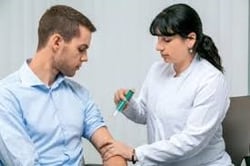 Setelah melewati gelombang kedua pandemi COVID-19, sektor usaha di area Jawa-Bali mulai dapat bernafas lega dengan berkurangnya restriksi aktivitas secara bertahap. Cakupan vaksinasi yang semakin meningkat juga menjadi angin segar bagi perusahaan untuk bersiap tancap gas kembali. Berangsur-angsur karyawan akan kembali ke tempat kerja dan beraktivitas seperti semula. Namun, benarkah ancaman COVID-19 sudah berlalu? Apakah perusahaan dapat serta merta kembali pada business as usual ataukah diperlukan langkah-langkah khusus supaya karyawan dapat kembali bekerja dengan aman?
Setelah melewati gelombang kedua pandemi COVID-19, sektor usaha di area Jawa-Bali mulai dapat bernafas lega dengan berkurangnya restriksi aktivitas secara bertahap. Cakupan vaksinasi yang semakin meningkat juga menjadi angin segar bagi perusahaan untuk bersiap tancap gas kembali. Berangsur-angsur karyawan akan kembali ke tempat kerja dan beraktivitas seperti semula. Namun, benarkah ancaman COVID-19 sudah berlalu? Apakah perusahaan dapat serta merta kembali pada business as usual ataukah diperlukan langkah-langkah khusus supaya karyawan dapat kembali bekerja dengan aman?
Meskipun indikator penanangan pandemi di Indonesia mulai menunjukkan trend positif, kita tentunya tidak dapat lengah. WHO terus mencatat munculnya varian-varian virus baru. Selain itu, ketimpangan cakupan vaksin dan sistem kesehatan di daerah juga menjadi perhatian khusus. Karena itu, diperlukan berbagai upaya supaya proses kembalinya karyawan ke tempat kerja tidak menimbulkan dampak negatif bagi karyawan dan perusahaan. Salah satu hal mendasar yang perlu menjadi perhatian adalah potensi bahaya di tempat kerja. Diperlukan adanya suatu proses untuk melakukan penilaian risiko sejak dini.
Health Risk Assessment (HRA) merupakan suatu proses yang selama ini umum dilakukan, terlebih pada tempat kerja yang secara tradisional dianggap memiliki risiko tinggi seperti industri migas, konstruksi, dan tambang. Pada situasi pandemi, perlu disadari bahwa terjadi pergeseran jenis hazard yang kita hadapi dan persepsi tradisional mengenai high-risk workplace tentunya tidak relevan pada konteks ini. Risiko tinggi saat ini ditemukan pada tempat kerja dengan karakteristik yang menunjang transmisi virus SARS-CoV-2 maupun tempat kerja dengan akses terhadap layanan kesehatan yang terbatas. Hal ini menyebabkan tingginya jumlah kluster COVID-19, misalnya, pada pekerja kantoran dan pabrik padat karya. Contoh lain adalah sulitnya manajemen COVID-19 pada pekerja yang memiliki mobilitas tinggi, bekerja di area terpencil, maupun tinggal bersama pada satu hunian pekerja.
Prosedur HRA dilaksanakan dengan mempertimbangkan bahaya yang ada di lingkungan kerja maupun yang timbul dari aktivitas pekerjaan sehari-hari. Penilaian yang komprehensif memberikan gambaran risiko kesehatan yang akan dihadapi karyawan saat kembali bekerja dan dapat menjadi panduan bagi manajemen untuk menerapkan kontrol risiko yang efektif dan efisien.
Hubungi kami untuk informasi lebih lanjut mengenai Health Risk Assessment: Hendra.Hendra@tuv.com
The Importance of Health Risk Assessment during the COVID-19 Pandemic
After passing the second wave of the COVID-19 pandemic, the business sector in the Java-Bali area began to breathe easy with the gradual easing of activity restrictions. The increasing vaccination coverage is also a breath of fresh air for companies to get ready to step on the gas again. Gradually, employees will return to the workplace and carry out their activities as before. However, is it true that the threat of COVID-19 has passed? Can companies immediately return to business as usual or are special steps needed so that employees can return to work safely?
Even though the indicators regarding the handling of the pandemic in Indonesia are starting to show a positive trend, we certainly cannot be careless. WHO continues to note the emergence of new virus variants. In addition, inequality in vaccine coverage and health systems in the regions is also of particular concern. Therefore, various efforts are needed so that the process of returning employees to the workplace does not have a negative impact on employees and the company. One of the basic things that need to be considered is the potential for hazards in the workplace. There is a need for a process to carry out a risk assessment early on.
Health Risk Assessment (HRA) is a process that is commonly carried out, especially in workplaces that are traditionally considered to have high risk, such as the oil and gas, construction, and mining industries. In a pandemic situation, it should be realized that there is a shift in the types of hazards we face and the traditional perception of a high-risk workplace is certainly not relevant in this context. High risk is currently found in workplaces with characteristics that support the transmission of the SARS-CoV-2 virus and workplaces with limited access to health services. This has led to a high number of COVID-19 clusters, for example, in office workers and labor-intensive factories. Another example is the difficulty of managing COVID-19 for workers who have high mobility, work in remote areas, or live together in one worker's residence.
The HRA procedure is carried out by considering the hazards that exist in the work environment as well as those arising from daily work activities. A comprehensive assessment provides an overview of the health risks that employees will face when returning to work and can be a guide for management to implement effective and efficient risk controls.
Contact us for more information about Health Risk Assessment: Hendra.Hendra@tuv.com


